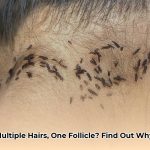Finding a bump on your scrotum can be alarming. If it’s a small, smooth, painless lump, it might be a sebaceous cyst. This guide provides clear, concise information about scrotal sebaceous cysts, guiding you through identification, causes, and treatment options.
What is a Sebaceous Cyst?
A sebaceous cyst is a small, typically benign lump that forms just beneath the skin. It develops when a sebaceous gland, responsible for producing oil (sebum) to lubricate skin and hair, becomes blocked. This blockage causes sebum to accumulate, forming a cyst. On the scrotum, these cysts often appear as whitish or yellowish bumps and are usually painless.
Identifying a Sebaceous Cyst: A Step-by-Step Guide
Regular testicular self-exams are crucial for men’s health. They help you become familiar with your scrotum’s normal anatomy, making it easier to detect any changes.
- Warm Up: Perform the exam during or after a warm shower or bath. Warm water relaxes the scrotal skin.
- Visual Inspection: Stand in front of a mirror and examine your scrotum for any visible changes like swelling or discoloration.
- Hands-On Exam: Gently roll each testicle between your thumb and fingers, feeling for any lumps, bumps, or changes in size, shape, or texture.
- Locate the Epididymis: The epididymis, a cord-like structure behind each testicle, is normal anatomy. Familiarize yourself with its feel to avoid mistaking it for a lump.
- Consistency is Key: Perform self-exams monthly to become familiar with your normal anatomy and detect any changes early.
What a Sebaceous Cyst Looks and Feels Like
A sebaceous cyst typically feels like a small, smooth, movable pea or marble under the skin. It may appear skin-colored or slightly yellowish. They are usually painless unless infected or very large.
Causes of Sebaceous Cysts
While the exact cause of a blocked sebaceous gland isn’t always clear, several factors may contribute:
- Excess Sebum: Overproduction of sebum increases the risk of blockages.
- Dead Skin Cells: Accumulation of dead skin cells can clog gland openings.
- Trauma: Skin damage can disrupt the sebaceous gland.
- Hormonal Changes: Fluctuations in hormones might influence sebum production.
- Genetics: Some individuals might be genetically predisposed to developing cysts.
Ongoing research continues to explore other potential underlying causes, including the role of keratin overproduction.
Symptoms: What to Watch For
Often, scrotal sebaceous cysts have no noticeable symptoms. You might simply discover a small, painless lump. However, if the cyst becomes infected, symptoms can include:
| Symptom | Description |
|---|---|
| Appearance | Small, round bump; skin-colored, white, or yellow |
| Texture | Smooth, rubbery, or firm; usually movable |
| Pain | Typically painless, but tenderness or pain with infection |
| Other Signs | Redness, swelling, warmth, pus drainage (if infected) |
When to See a Doctor
While generally harmless, consult a doctor if:
- The cyst becomes painful.
- It grows rapidly.
- You notice signs of infection (redness, swelling, warmth, pus).
- You’re uncertain about the lump’s nature.
- You experience penile discharge in conjunction with other symptoms.
Diagnosis and Treatment
Diagnosis typically involves a physical exam. Your doctor might aspirate the cyst (withdraw fluid with a needle) for analysis to confirm the diagnosis and rule out other conditions.
Treatment options vary:
- Warm Compresses: Applying warm compresses can sometimes help reduce inflammation and promote drainage.
- Incision and Drainage: Infected cysts may require draining by a doctor.
- Surgical Removal: This minor procedure completely removes the cyst and prevents recurrence. It’s generally recommended if the cyst is large, bothersome, or recurrent.
Risks and Complications
The primary risk associated with sebaceous cysts is infection. Prompt medical attention is crucial if you suspect infection.
Prevention
While there’s no guaranteed prevention method, good hygiene can help minimize the risk of blocked pores.
Differentiating Sebaceous Cysts from Other Conditions
Several other scrotal lumps can resemble sebaceous cysts. These include:
| Condition | Characteristics |
|---|---|
| Ingrown Hair | Small, red bump; often with a visible hair trapped underneath |
| Pimple (Folliculitis) | Inflamed hair follicle; small, red, possibly pus-filled |
| Epidermoid Cyst | Similar to sebaceous cyst; may express cheesy material when squeezed |
| Pilar Cyst | Firm, smooth, skin-colored or yellow; typically on the scalp, but can occur elsewhere |
| Epididymal Cyst | Painless, fluid-filled sac in the epididymis |
| Hydrocele | Fluid-filled sac around a testicle; usually painless |
| Varicocele | Enlarged veins in the scrotum; feels like a “bag of worms” |
| Inguinal Hernia | Bulge near the groin; may increase in size with coughing |
| Testicular Cancer | Hard lump on testicle; usually painless |
| Epididymitis | Inflammation of the epididymis; pain, swelling, tenderness |
| Testicular Torsion | Twisting of the spermatic cord; medical emergency; sudden, severe pain |
Note: This table is for informational purposes only and is not a substitute for professional medical advice. Always consult a doctor for diagnosis and treatment. The information provided here reflects current understanding and is subject to change as research advances.
Frequently Asked Questions
- Are sebaceous cysts cancerous? No, they are almost always benign.
- Can I squeeze a sebaceous cyst? No, squeezing can introduce bacteria and cause infection.
- Will it go away on its own? Some may resolve spontaneously, while others persist or enlarge. Consult a doctor for any new lump.
Disclaimer
This information is for educational purposes only and is not a substitute for professional medical advice. Consult a qualified healthcare professional for any health concerns or before making any decisions related to your health.
Resources
- American Academy of Dermatology (AAD)
- National Institutes of Health (NIH)
- (Find a local dermatologist or urologist – Suggest adding a tool or directory link here if available)
- Hydro Extrusions USA Leads North American Aluminum Profile Solutions - December 28, 2025
- Hydro North America Leads Aluminum Extrusion Solutions Across Diverse Industries - December 27, 2025
- Hydro Extrusion North America Provides Custom Solutions Across Diverse - December 26, 2025
















